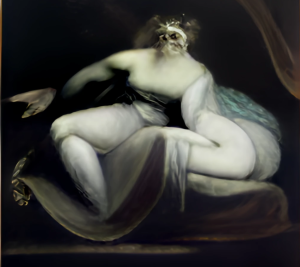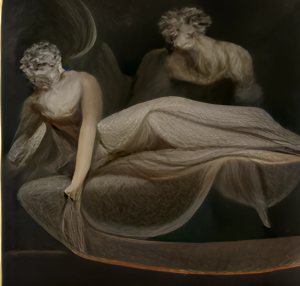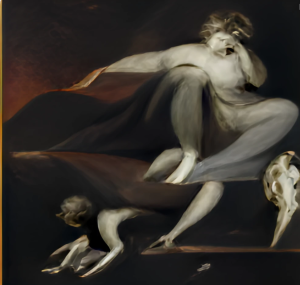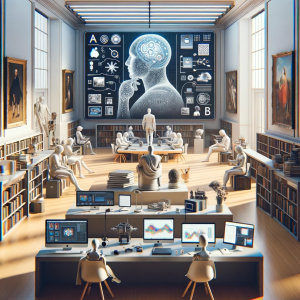Dreamlike
by Shems Benmosbah
Abstract
This chapter delves into the interplay between the sublime and Henry Fuseli’s artistic legacy, as reflected through the analysis of three AI-generated images inspired by his work. By juxtaposing these contemporary interpretations with Fuseli’s original exploration of awe, terror, and the ineffable, the study draws upon the thematic depths of metamorphosis and the unconscious, guided by the narratives of Franz Kafka’s The Metamorphosis and the psychoanalytic perspectives of Sigmund Freud. It underscores the AI’s capacity to both echo and expand upon Fuseli’s Romantic visions, highlighting the nuanced dialogue between historical artistry and the frontier of digital reimagination.
As a student of art history, I have long been captivated by the works of Henry Fuseli, whose paintings offer captivating explorations of the human psyche, imagination, and the supernatural. Fuseli’s oeuvre, characterized by its dramatic compositions and evocative themes, invite interpretations that resonate deeply with our emotions and imaginations. The decision to focus on the following AI-generated artworks is motivated by a desire to understand how contemporary computational creativity can mirror, reinterpret, and extend Fuseli’s thematic preoccupations into the digital age. This chapter thus represents an exploration of the fusion between art and AI, with a specific focus on Fuseli. I aim to offer a contemporary reinterpretation of Fuseli’s compositions particularly addressing matters of the sublime, visual limits, and empty spaces. Through this interdisciplinary approach, I aim to shed new light on Fuseli’s oeuvre and its relevance in the modern era by answering the following questions: Can AI capture Fuseli’s emotional intensity and psychological depth? And what insights do AI interpretations provide on Fuseli’s engagement with the sublime and the supernatural? while also exploring the potential of AI as a tool for artistic exploration and interpretation.
Henry Fuseli (1741-1825) was a Swiss-born painter, draughtsman, and writer who played a pivotal role in the Romantic movement in Britain. Known for his dramatic and imaginative works that often delved into themes of the supernatural, the sublime, and human psychology, Fuseli carved a distinct niche for himself in the history of art. Despite having no formal education in the arts and lacking a network of aristocratic patrons, Fuseli’s profound classical education and innate talent for storytelling through his art enabled him to emerge as a significant figure in late 18th and early 19th-century British art.[1] Fuseli’s work is characterized by its emotional intensity, often featuring idealized figures caught in moments of extreme action or emotional turmoil against neutral or fantastical backgrounds. His fascination with the works of Dante Alighieri, William Shakespeare, and John Milton influenced his choice of subjects, which frequently explored themes of horror, myth, and romance. One of Fuseli’s most iconic works, The Nightmare (1781), encapsulates his ability to evoke terror and fascination, portraying a demonic incubus perched on a sleeping woman’s chest, a vivid manifestation of the gothic and the macabre that defined much of his oeuvre. Throughout his career, Fuseli also expressed a keen interest in aspects of applied science and medicine, which informed his understanding of the human body and its expressive potential in art. This, coupled with his classical education, allowed Fuseli to infuse his works with a depth of intellectual and cultural references that resonated with the Romantic era’s preoccupations. In addition to his contributions as an artist, Fuseli was a prolific writer and critic, engaging with contemporary debates on art, aesthetics, and society. His writings, much like his paintings, reflected his deep engagement with the philosophical and cultural currents of his time.Fuseli’s legacy extends beyond his distinctive style and thematic preoccupations, embodying the Romantic spirit’s fascination with the boundaries of imagination and the exploration of the human condition. His works continue to captivate and inspire, offering a window into the complexities of the Romantic mind and the enduring appeal of the sublime in art.
The advent of AI in art presents a shift in creative expression and art analysis, reflecting an intriguing synergy between technology and human creativity. It felt essential to review literature which explores the intersection of AI-generated art with the thematic elements in Henry Fuseli’s works, as it provides insights into existing scholarship and critical perspectives on this connection. Fuseli’s paintings, renowned for their vivid portrayal of the sublime, the dreamlike, and the landscape of human emotions, have long been the subject of scholarly attention. The sublime, a concept that has fascinated philosophers, artists, and writers for centuries, refers to an aesthetic quality that evokes a sense of awe, grandeur, and sometimes terror, in the face of the vast, the infinite, or the incomprehensible. It is has been defined as an experience that transcends beauty, stirring deeper emotions that can both elevate and overwhelm the observer. In relation to Henry Fuseli, the sublime plays a pivotal role in understanding the thematic and emotional depth of his artwork, particularly in how he engages with the darker, more mysterious aspects of human experience and the natural world. The retrospective analysis by editors of ARTnews revisits Mario Praz’s 1953 critique of Fuseli, offering a historical perspective on the artist’s oeuvre and the emotional gravity it conveyed in the 18th century. It also provides a critical benchmark for assessing the fidelity of AI-generated images to the thematic and stylistic essence of Fuseli’s oeuvre. This juxtaposition allows for an exploration of how Fuseli’s exploration of the sublime and the macabre is re-envisioned through digital technology. By contrasting Praz’s insights with AI’s modern renditions, we gain a nuanced understanding of the evolution of artistic interpretation and the challenges and possibilities AI presents in capturing and reinterpreting Fuseli’s complex emotional landscapes.[2] Furthermore, Marc Barham’s analysis in Counter Arts brings into focus Fuseli’s iconic work The Nightmare, linking it to the concept of ‘horror vacui.’ This notion is particularly relevant to AI artistry, where algorithms are programmed to forgo emptiness, often filling spaces with intricate patterns or interpretations informed by vast datasets.[3] Barham’s discourse potentially enriches the analysis of AI-generated images, where the AI’s propensity to populate voids might resonate with or diverge from Fuseli’s intentional use of space and emphasis. The exploration of the sublime in Fuseli’s art is further extended by Alan Edward Boulton’s thesis, The Embodiment of Sublimity: Discourses Between Visual, Literary and Philosophical Conceptions of Sentience in The Drawings of Henry Fuseli, 1770-78 which delves into the discourses bridging the realms above as they pertain to Fuseli’s work.[4] This thesis could be instrumental in understanding the complexities of translating the multi-faceted nature of Fuseli’s sublime into digital interpretations by AI, examining how the embodied sentience and emotive potency in Fuseli’s drawings might be echoed or transformed. In a more focused study on gender representation, The Courtauld’s exhibition Fuseli and the Modern Woman: Fashion, Fantasy, Fetishism examines Fuseli’s portrayal of women, which intersects with modern perceptions of fashion and fantasy.[5] This examination offers a nuanced understanding of how AI might replicate or reinterpret the layered themes of gender and identity that Fuseli navigated through his art. Lastly, Scotland’s National Galleries’ glossary entry of the ‘sublime’ provides foundational knowledge critical in understanding the term in its art historical context, which allows for a more informed analysis of how AI-generated images might encapsulate or deviate from traditional conceptions of the concept.[6]
At the beginning of my research, I utilized DALL-E mini, an AI model designed for image generation, to create visuals reflective of Henry Fuseli’s thematic and stylistic characteristics. This tool transforms textual prompts into visual art, emulating aspects of human creative expression. I initiated this process by feeding the AI model with carefully formulated, yet simply worded prompts. The prompts I employed were: “Henry Fuseli where creativity resides,” “Henry Fuseli sublime dreams human emotion,” and a slight variation of the first prompt to test the AI’s response to subtle changes in input. The utilization of AI to generate images inspired by Henry Fuseli’s themes has unveiled a fascinating intersection between 18th-century Romanticism and contemporary digital technology. By inputting Fuseli’s thematic concerns into an AI model, the resulting images not only mirror his iconic style but also present novel interpretations that extend beyond traditional artistic boundaries. These AI-generated works, while echoing Fuseli’s preoccupation with the sublime and the human psyche, introduce unique visual narratives and motifs, showcasing the AI’s capacity for creative expression. This approach does not simply replicate Fuseli’s art but rather engages in a dynamic dialogue with it. These AI generated works—referred to as Image 1, Image 2, and Image 3—serve as the primary visual data for this study, offering a basis for interpretative discussions. They reflect Fuseli’s dramatic use of contrast of lights, the tension in the portrayal of figures, and the ethereal ambiance that characterizes much of his work, reminiscent of his masterpiece The Nightmare. Through these images, the AI’s interpretation of the prompts provided is scrutinized, allowing for an in-depth exploration of the capabilities of AI in mimicking human-like artistic creativity and understanding complex artistic concepts.

– Image 1 introduces a lone figure captured in a pose that echoes Fuseli’s dramatic flair, emphasizing the sublime’s ethereal aspect.
This image captures a lone figure amidst a transition, surrounded by deep shadows that fade into an impenetrable darkness. The figure is illuminated from an unseen source, highlighting its pale, almost translucent skin against the surrounding obscurity. The figure’s pose is both graceful and contorted, suggesting a struggle or acceptance of the transformation it undergoes. Notably, the face blurs into a skull-like visage, symbolizing a metamorphosis from life to an ethereal existence. The surrounding air is filled with swirling mists or fabric, emphasizing the dynamic process of change.

– Image 2 presents two figures depicted in the midst of a dreamlike landscape, their forms blending into and emerging from the background. The figures are caught in an ambiguous dance of interaction, their movements fluid as if they are both leading and following a cycle of endless change. Their features are softly indistinct, reinforcing the theme of metamorphosis as they seem to be transforming into each other or into something new altogether. This proves representation mirrors Fuseli’s interest in the fluidity of human emotion and the dream state as a realm of infinite possibility and transformation.

– Image 3, created in response to a nuanced alteration of the initial prompt, offers a fresh take on Fuseli’s thematic concerns, showcasing the AI’s ability to vary its interpretations. This image presents a scene of tumultuous interaction among multiple figures, where the concept of metamorphosis is manifested in the physical merging and distortion of bodies. The composition is dominated by darker tones, creating a sense of depth and turmoil. Figures are elongated and intertwined, with limbs and faces stretching and morphing in an expression of chaos and transformation. This visual chaos reflects Fuseli’s exploration of human psyche and emotion, depicting a metaphysical battleground of transformation where identities are lost, found, and forever changed in the process.
In transitioning to the interpretation and analysis segment of this research, I delve into the AI-generated images’ nuanced reflections of Fuseli’s thematic and stylistic predilections, particularly through the lenses of metamorphosis and psychoanalysis. The incorporation of Franz Kafka’s The Metamorphosis and the psychoanalytic theories of Sigmund Freud serves as a foundational basis for interpreting the transformative and subconscious elements evident in these images, contextualizing them within Fuseli’s exploration of the human psyche, dreams, and the darker aspects of human emotion. The theme of metamorphosis, so central in Kafka’s narrative, offers an invaluable perspective for interpreting AI-generated visuals. Kafka’s tale, which depicts an individual’s abrupt and grotesque transformation into an insect as a profound metaphor for alienation and existential disorientation , finds echoes in Fuseli’s work, such as in The Thieves’ Punishment (1772). This piece, which draws from Dante’s Inferno, visually encapsulates themes of transformation and torment that align with Fuseli’s interest in depicting the fluidity of human experience. The AI images, in reflecting these themes, not only resonate with Fuseli’s and Kafka’s examinations of identity and change but also offer new visual narratives that extend the conversation into the realm of digital modernity. Psychoanalytic theory, particularly Freud’s explorations of dreams and the unconscious, further enriches this analysis. Freud’s seminal work, The Interpretation of Dreams delves into the symbolic language of dreams, positing them as windows into the unconscious mind, where latent desires and fears reside.[7] This psychoanalytic perspective offers valuable insights into Fuseli’s work, notably his painting The Nightmare, which visually encapsulates the tension between the known and the unknowable, the seen and the unseen. The AI-generated images, in their surreal representations and abstracted forms, evoke a similar sense of navigating the subconscious, albeit through a contemporary digital lens. While these images capture the outward forms associated with Freudian psychoanalysis, they may not fully encapsulate the emotional depth and subtleties that Fuseli’s hand-rendered works convey.
The AI-generated images invite a closer visual analysis that connects them directly to Fuseli’s iconic pieces. For instance, the first AI image, drawing inspiration from The Thieves’ Punishment, captures the essence of horror and transformation with serpentine figures entangled in a dramatic display of metamorphosis. Inspired by Dante’s Inferno, it is also reminiscent of the doomed protagonist in The Metamorphosis.[8] This visual parallel not only underscores the thematic continuity of transformation but also reflects the AI’s capacity to reinterpret Fuseli’s fascination with classical mythology and the human condition through a contemporary lens.
Similarly, the second AI image, which might be seen as echoing The Incubus Leaving Two Sleeping Women (1810), presents a nuanced depiction of vulnerability and terror through its portrayal of figures caught in a moment of eerie tranquility. This iconic work, emblematic of the tension between reality and the unseen, parallels Freud’s assertion of dreams as manifestations of latent desires and fears.[9] The curve of the bodies and the dramatic turn of the chest towards the viewer recall Fuseli’s mastery in conveying complex emotional states and narratives through body language and composition. The AI interpretations, with their surreal depictions, echo this journey into the subconscious, albeit from a modern perspective that blends Freudian psychoanalysis with digital artistry.
I wish to now synthesize the insights garnered from the analysis of AI-generated images within the broader context of Henry Fuseli’s artistic legacy, exploring how these modern interpretations interact with and expand upon the themes Fuseli so vividly engaged with. This integration not only highlights the AI’s capabilities in reimagining Fuseli’s thematic preoccupations and stylistic nuances but also offers a reflection on the continuing impact of Fuseli’s work in contemporary discussions on art and technology.
Exploring the thematic resonance of metamorphosis through Franz Kafka’s The Metamorphosis, alongside the psychoanalytic insights offered by Sigmund Freud’s theories, forms the core of our analysis of AI-generated images inspired by Henry Fuseli’s work. This approach underscores how AI, in reinterpreting Fuseli, taps into the enduring human fascination with transformation and the depths of the subconscious. Kafka’s allegory of profound personal transformation and Freud’s exploration of the unseen landscapes of the mind resonate with Fuseli’s visual depictions of the surreal and the uncanny. The AI-generated images, informed by these literary and psychoanalytic frameworks, not only mirror the essence of Fuseli’s exploration of human emotion and identity but also extend these themes into the digital realm. This synthesis highlights the capacity of AI to engage with and expand upon classical art themes, offering new perspectives on metamorphosis and the exploration of the subconscious as timeless concerns, thereby bridging historical artistic inquiry with contemporary technological innovation.
Kafka’s The Metamorphosis serves as an allegory for alienation and the disintegration of identity. This narrative resonates with Fuseli’s artistic preoccupation with the surreal and the monstrous, notably in works like The Nightmare, where the intrusion of a demonic figure upon a sleeping woman visually manifests the intrusion of the uncanny into the familiar. The AI-generated images, in drawing inspiration from these themes, navigate the Kafkaesque landscape of transformation, presenting a digital reinterpretation that both echoes and diverges from the original narrative. The AI’s ability to render these complex themes visually prompts a reevaluation of the ways in which transformation and identity are depicted in the digital age, reflecting a continuity of existential concerns from Fuseli to Kafka to now. Furthermore, Freud’s theories, particularly his examination of dreams as windows to the unconscious, deepen our understanding of Fuseli’s work, which often straddles the line between reality and the dream state. Freud’s notion of the uncanny, where the familiar becomes eerily foreign, finds visual echo in Fuseli’s depictions of ethereal figures and dream-induced terror. The AI-generated images, by leveraging data and algorithms, attempt to capture this Freudian uncanny, creating visuals that are at once familiar and unsettling. In doing so, these images offer a new medium through which the uncanny, and by extension, the subconscious fears and desires that Fuseli and Freud explored, can be examined and experienced.
Through the lens of AI, Fuseli’s exploration of the sublime, the terrifying, and the uncanny is recontextualized within a framework of digital creativity, suggesting that the core human preoccupations with identity, transformation, and the depths of the psyche remain unchanged, even as the mediums through which we explore them evolve. The AI-generated images serve not only as a testament to Fuseli’s lasting influence on art and culture but also as a reflection on the role of technology in both preserving and transforming the legacy of classical art. They invite us to consider how AI can be used not just as a tool for replication but as a means of adding new dimensions to our understanding of art, allowing for a dynamic interplay between the historical and the contemporary, the human and the artificial. This expanded analysis underscores the complexities and potential of using AI to interpret and reimagine Fuseli’s themes for the modern era, highlighting the enduring relevance of his work and the transformative power of technology in art interpretation and creation. It reveals the dialogic potential between classical art themes and AI, where technology becomes a bridge connecting past and present, offering new insights into the universal human experience depicted in art. The AI’s ability to evoke Fuseli’s thematic concerns—such as the fluidity of human identity, the exploration of the subconscious, and the portrayal of intense emotional states—demonstrates the potential of technology to engage with complex artistic and psychological themes.
However, this integration also uncovers the limitations inherent in the AI’s interpretations. While the AI-generated images successfully evoke certain stylistic and thematic aspects of Fuseli’s work, they lack the emotional depth and nuanced understanding of the human psyche that Fuseli conveyed through his mastery of paint and canvas. This stems from Fuseli’s ability to intertwine his personal insights, cultural context, and creative intuition, crafting artworks that resonate deeply on a human level. AI, while capable of mimicking Fuseli’s stylistic and thematic signatures, lacks the intrinsic emotional experience and the nuanced understanding of human nature that characterize Fuseli’s paintings. The AI-generated images, despite their visual similarities to Fuseli’s work, often fall short of conveying the same emotional resonance and psychological intricacies. This discrepancy highlights the challenges of capturing the full spectrum of human emotion and psychological complexity through digital means.
Ultimately, this research reaffirms the significance of Fuseli’s artistic legacy, spotlighting its resonance within today’s technological and artistic landscapes. It reveals the vast potential and inherent constraints of leveraging AI as a medium for artistic exploration, offering new perspectives on classical themes and fostering a richer appreciation for the intersections of art and technology. Through this interdisciplinary lens, the study hopes to advance the discourse on technology’s role in art, highlighting the enduring power of the dreamlike to unlock new understandings of the human experience, both past and present.

Shems Benmosbah is a fourth-year Bachelor’s student in Art History and Communication at the University of Ottawa. Currently working at the National Gallery of Canada, her research interests lie in the integration of artificial intelligence in art historical analysis.
- Martin. Myrone, Christopher. Frayling, and Marina Warner, Gothic Nightmares : Fuseli, Blake and the Romantic Imagination (London: Tate Publishing, 2006), p.10. ↵
- The Editors of ARTnews, “From the Archives: Mario Praz on Henry Fuseli, in 1953,” ARTnews.Com (blog), October 19, 2018, https://www.artnews.com/art-news/retrospective/archives-mario-praz-henry-fuseli-1953-11183/. ↵
- Marc Barham, “Horror Vacui and ‘The Nightmare’ (1781) by Henry Fuseli.,” Counter Arts (blog), September 15, 2021, https://medium.com/counterarts/horror-vacui-and-the-nightmare-1781-by-henry-fuseli-47049d748f0f. ↵
- Alan Edward Boulton, “THE EMBODIMENT OF SUBLIMITY: DISCOURSES BETWEEN VISUAL, LITERARY AND PHILOSOPHICAL CONCEPTIONS OF SENTIENCE IN THE DRAWINGS OF HENRY FUSELI, 1770-78,” PDF, accessed February 12, 2024, https://etheses.bham.ac.uk/id/eprint/5555/1/Boulton15MPhil_redacted.pdf. ↵
- “Fuseli and the Modern Woman: Fashion, Fantasy, Fetishism - The Courtauld,” accessed February 12, 2024, https://courtauld.ac.uk/whats-on/fuseli-and-the-modern-woman-fashion-fantasy-fetishism/. ↵
- “Sublime,” accessed February 12, 2024, https://www.nationalgalleries.org/art-and-artists/glossary-terms/sublime. ↵
- Sigmund Freud, “The Interpretation of Dreams.Pdf,” 1900, https://psychclassics.yorku.ca/Freud/Dreams/dreams.pdf. ↵
- Franz Kafka, “The Metamorphosis” (1912). ↵
- Sigmund Freud, “The Interpretation of Dreams.Pdf,” 1900, p.48, https://psychclassics.yorku.ca/Freud/Dreams/dreams.pdf. ↵

